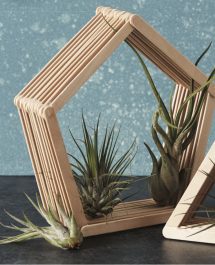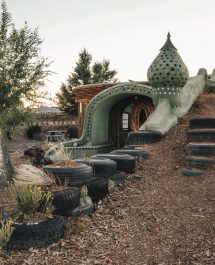
PHOTOGRAPHS BY JONAS JUNGBLUT ✷ ILLUSTRATIONS BY TIM LAMB ✷ STORY BY SANDRA S. SORIA
Talk about your dream jobs. Tim Lamb is an illustrator and creative director who drew his way into a career in animation, working for heavy-hitters such as Dreamworks. Kelli Lamb is a writer with a great eye who parlayed her skills into the editor-in-chief position of the digital magazine, Rue. They were happily living in San Francisco in a curvy, character-laden Victorian apartment when work called Tim to Hollywood.
And that’s where our conversation picks up.
Q: First things first, how did you end up in this cool house with these sweet jobs?
Kelli: After college, I worked in a corporate setting in e-commerce and then I moved to San Francisco when I met Tim. I had a pretty difficult time finding even an interview in the same industry. But I had created a fashion blog for fun that never really got off the ground. I really enjoyed it as kind of an outlet from my stuffy, corporate work. So, I started researching how I could translate that into an actual job. Then, in 2011, I found Crystal Palecek, the founder of Rue, and started interning for her. We’re a very small team and I just dove in fully. I ditched the idea of returning to a cubicle and decided to go full force with Rue.
Tim: Hers is a dream job in one sense because Kelli gets to work from home. I’m so jealous of that because I have been going to an animation studio for the past 13 years. It’s been a long time. But I went to art school in San Francisco. Both of my parents met as illustrators in the ‘70s and then continued their artistic careers. So I come from an artistic family. I could’ve told them I was going to law school and they would’ve forbid it.
Q: What brought you to L.A.?
Kelli: The studio that Tim was working at was an arm of Dreamworks, called PDI. They closed that studio in 2015 and so he was transferred down here. So… we got married, then went on our honeymoon, and then met the movers at our apartment the day we got back and packed up for L.A.
Tim: It was an interesting move because I was in the middle of working on Trolls and when they announced the closure they gave some of us options to continue our positions in L.A. After a lot of discussion, Kelli and I decided it would be good for us to come down, finish the movie, explore a new city, and then get right back up to San Francisco.
Q: So L.A. must have surprised you—in a good way?
Kelli: I definitely was known for saying, “We’ll be back in a year! We will never live in L.A.” Now, it’s definitely home. I think from the outside looking in people really assume that it’s a lot of Hollywood and superficial, but there’s actually a really robust art community. And then the design community down here is just inspiring. There’s a lot of great shopping for home goods and the flea markets. We were both really surprised.
Tim: Being from San Francisco it’s really nice to be able to just walk around to wherever you want to go to. When we moved down here we wanted that feature and we found it in the Los Feliz/Silver Lake area.




Q: How was the transition from apartment in the city to this house and residential area?
Kelli: Our apartment there definitely had a lot of character—archways and beautiful molding. Here, though, the location is ideal and the owners had done a really great job of updating it. The kitchen and bathrooms were a supreme luxury coming from our San Francisco apartment. But it definitely was a white box. Our furniture looked very weird in it at first. So we had to reevaluate what our L.A. style looks like. But I love that we have a giant magnolia tree out front and you can look outside and see hummingbirds. In San Francisco, you just saw the neighbor in the building across the street.
Tim: We went from waking up to the sound of people yelling and horns honking to dappled sunlight coming through the window with the sound of birds chirping. So there’s that.
Q: So how has the move impacted your style—are L.A. Kelli and Tim different from San Fran Kelli and Tim?
Kelli: That’s so funny because considering my job often involves defining spaces in terms of style I never can really put a pin on what ours is. I would say in San Francisco, it was a lot more eclectic—it was our first home together. It was a little all over the place, but it worked well, I think. We lived near the Haight District and so some of the pieces in our San Francisco apartment were things that we found discarded on the street.
Tim: Not really.
Kelli: Okay, that does paint a different picture. So we found a couple of side tables that we brought home. I would say the common thread between the two places is the art collection. A lot of the pieces are from Tim’s friends or people he works with. And so that has kind of stayed the same. But I think we definitely have a softer, more modern style here; it’s more comfortable.
Q: Did you have to swap out a lot of furniture—maybe put those side tables back on the street?
Kelli: We wanted this space to reflect the peacefulness of the area, but it was confusing—mostly the living area. I was like, “Our sofa is just in the middle of this big white box. What do we do?” Through work I had been connected with Haley Weidenbaum, a designer with Home Polish and she helped with the initial layout and picking the right-size sectional. But then it has changed as we’ve lived here, we’ve moved the artwork around, got a more comfortable sofa, and kind of eased into what we wanted this space to be. We’ve been making it our own from there.
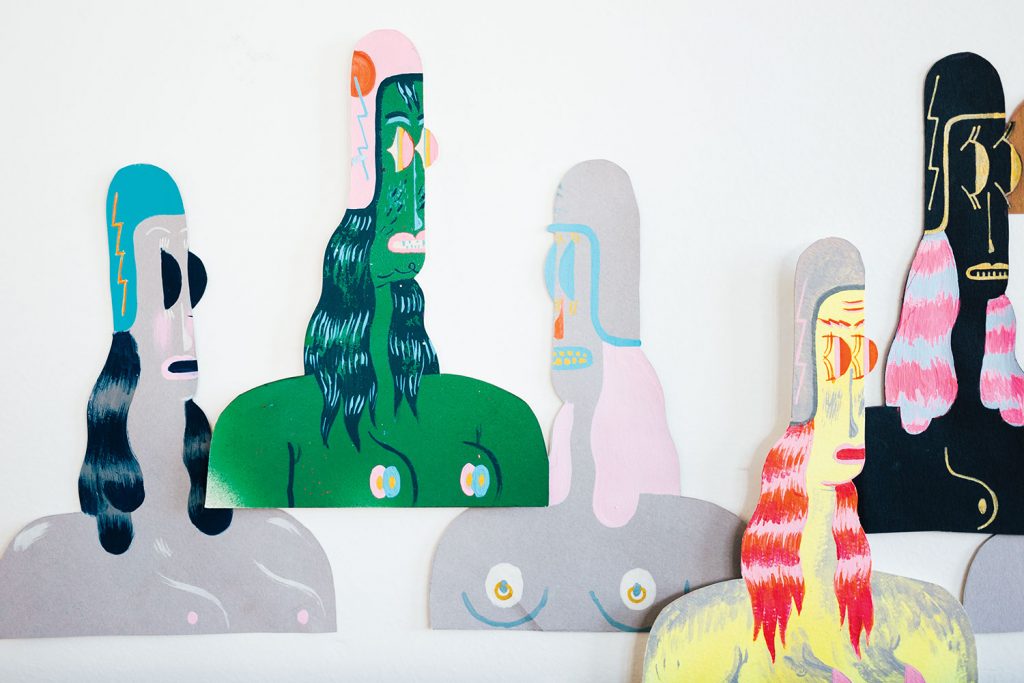
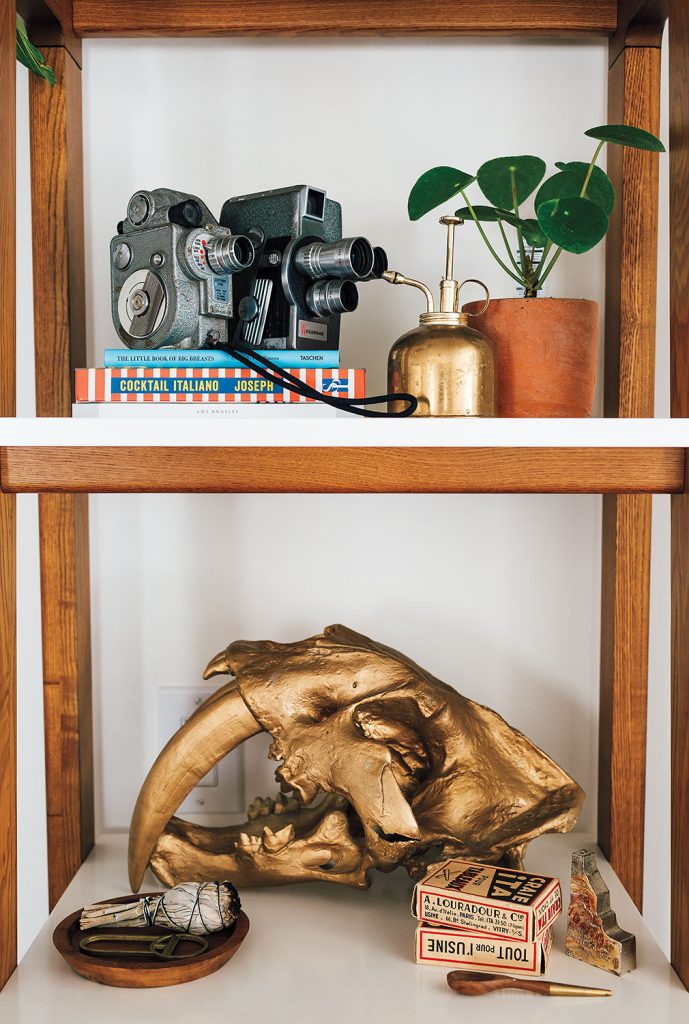



Q: How did you put your stamp on it?
Kelli: I would say besides the art it’s definitely in the textiles—like the cool pillows on our daybed. There’s still a bit of that California Bohemian pattern mixing there, but done very softly I think. Not too bold, not too over the top. Comfort is really important; we wanted to make it a place that we both really enjoy being in. At first we had a really modern West Elm sofa and it was almost painful to sit on. It was really cute and sleek, but we wanted something that was more cozy and welcoming to watch movies. Oh, and we have two cats who do embarrassing things and we wanted to make sure they’re comfortable, too. So a lot of soft blankets are key.
Q: Is it hard settling on something since you’re both so visual and presented with so many options at work?
Kelli: Even though from the outside it might look like I’m the more design-y one, I really appreciate Tim’s artistic eye and so we work well together. We agree on everything that we bring in. So even though I might be writing four articles about homes a week, it’s rare that I see something that I’m like, Well, now we have to change everything. I feel pretty confident in my own tastes.
Q: Tim, your studio is such a cool space. Did you have carte blanche here?
Tim: We like to joke that as we update things down here, the castoffs—rugs and what have you—end up in my office. My studio is really an amalgamation of all the rejects. But actually, it works out nicely. My studio is really functional. I have a side table that my brother-in-law made for us—it was actually the table that our wedding cake was on—that I use to hold my color palette for whatever I’m painting. Everything in my studio seems to have the backstory.
Q: And Kelli, do you have a designated workspace?
Kelli: My designated workspace is the dining room table. I had a desk set up in a bedroom that we used for storage and the litter box. But I really enjoy working at the dining table just because it’s open; I can see out the front and back windows. I’ll sit at the dining table and I can see the hummingbirds hanging out, which makes work much more pleasant than being in a dark office room with the cat box. It’s my happy space—within our happy place.
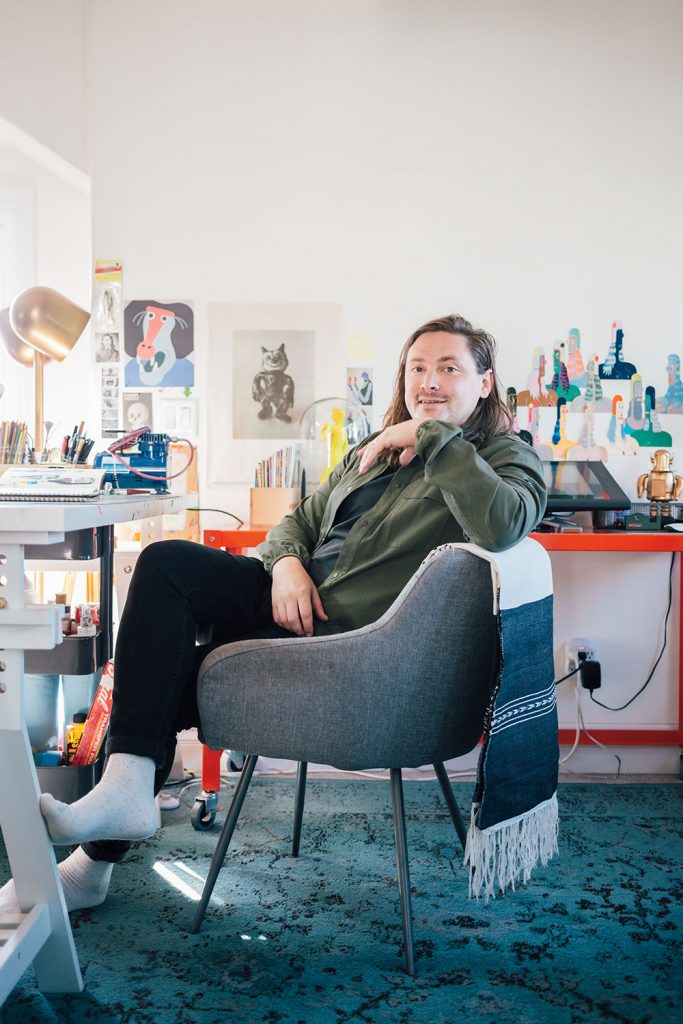





Ideas Worth Stealing
Kelli’s advice for personalizing a rental—or any blank boxy space.
Gain trust: Develop a relationship with the landlord so you can make more substantial changes. In this case, the homeowners trusted Kelli’s taste and Tim’s artful eye to install lighting, paint the redwood deck, and hang art.
Speaking of lighting: Lighting is so important to layering attitude into a home that lacks architectural interest. You can really make a place feel more cozy or interesting or romantic through lighting. They added sconces and a modern chandelier in the dining room, and a pendant light in the sunroom.
Weave in textiles: Use rugs to define “rooms” within an open floor plan— even a small one. Rugs add a layer of pattern while they lend each area a clear separation. Pillows and throws also add dimension to plain rooms, along with coziness and eye-catching designs.
Art Class: Clean, gallery-white walls create an ideal backdrop for art, and art is the fastest way to make a house a home. For gallery walls, work out an eye-pleasing arrangement of various-size works on a flat surface before nailing pieces to the walls. Worried about turning rented walls to Swiss cheese? Use 3M’s Command damage-free hangers.

